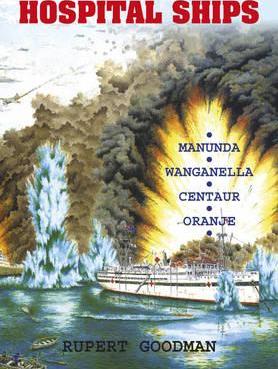Hospital ships have been in use since at least the days the British fought off the Spanish Armada says Rupert Goodman in Hospital Ships.

Rupert Goodman Tingalpa Qld: Boolarong Press, 2016
Paperback 310pp. RRP $29.99
Goodman covers the subject of hospital ships in some detail albeit from a predominantly Australian viewpoint and the book is rich in facts and especially figures.
The author leads the reader through the historical development of hospital ships pre-World War I, the evolution through both World Wars and then finishes off with a discussion of the modern trends.
Between the history and the future of hospital ships Goodman describes in depth four of the Australian hospital ships, Manunda, Wanganella, the ill-fated Centaur and the Dutch ship Oranje, devoting a chapter of the book to each. Each chapter describes the ship prior to being converted and commissioned as a hospital ship, the trips made as a hospital ship and the subsequent post-war activities of the ship.
Hospital ships essentially played two roles for the ill and wounded military personnel: namely the transportation of them and their care. The author explains the different requirements for each role referring to them as ‘military’ hospital ships and ‘naval’ hospital ships respectively. Considerable attention is also devoted to an additional, somewhat complicating role usually assigned to hospital ships, which is that of transporting troops to the war.
Pure hospital ships are known as ‘white’ ships whereas when a ship is used both as a hospital ship for transporting patients away from the front and troops towards the front it becomes a ‘black’ ship.
The author explains the Geneva Convention as it applies to hospital ships and discusses the many contraventions of the convention and the complications arising from dual purposing. One dilemma is whether to ensure the ship conforms to stringent Geneva Convention rules requiring painting the ship white, with red crosses and bright illumination during nighttime operations or not. If belligerents do not observe conventions, then making a hospital ship highly visible simply makes it a better target.
There are many examples, including HMAH Ships Manunda and Centaur, of hospital ships being deliberately targeted. The book contains a comprehensive set of appendices including Hospital Ship Standing Orders, the Geneva Convention Articles, Roll of Honour for those who served on Australian Hospital Ships, details of the trips made by the four ships and a clear list of abbreviations used.
The book is a low-cost publication being paperback bound and low-quality photographs. Having said that, there are many relevant and interesting photographs of the ships and the personnel who served on them.
The subject of this book which may be summarized as Australian hospital ships of the twentieth century, is a narrow one, but if that subject is of interest, then this book is a ‘must read’ for the sheer range of data it provides. I found the book particularly interesting in its descriptions their conversions to hospital ships and their lives as hospital ships.
Reviewed for RUSI by Kevan Sanderson, July 2020
Contact Royal United Services Institute about this article.






